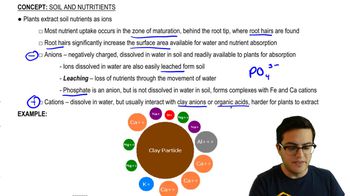Table of contents
- 1. Introduction to Biology2h 42m
- 2. Chemistry3h 40m
- 3. Water1h 26m
- 4. Biomolecules2h 23m
- 5. Cell Components2h 26m
- 6. The Membrane2h 31m
- 7. Energy and Metabolism2h 0m
- 8. Respiration2h 40m
- 9. Photosynthesis2h 49m
- 10. Cell Signaling59m
- 11. Cell Division2h 47m
- 12. Meiosis2h 0m
- 13. Mendelian Genetics4h 44m
- Introduction to Mendel's Experiments7m
- Genotype vs. Phenotype17m
- Punnett Squares13m
- Mendel's Experiments26m
- Mendel's Laws18m
- Monohybrid Crosses19m
- Test Crosses14m
- Dihybrid Crosses20m
- Punnett Square Probability26m
- Incomplete Dominance vs. Codominance20m
- Epistasis7m
- Non-Mendelian Genetics12m
- Pedigrees6m
- Autosomal Inheritance21m
- Sex-Linked Inheritance43m
- X-Inactivation9m
- 14. DNA Synthesis2h 27m
- 15. Gene Expression3h 20m
- 16. Regulation of Expression3h 31m
- Introduction to Regulation of Gene Expression13m
- Prokaryotic Gene Regulation via Operons27m
- The Lac Operon21m
- Glucose's Impact on Lac Operon25m
- The Trp Operon20m
- Review of the Lac Operon & Trp Operon11m
- Introduction to Eukaryotic Gene Regulation9m
- Eukaryotic Chromatin Modifications16m
- Eukaryotic Transcriptional Control22m
- Eukaryotic Post-Transcriptional Regulation28m
- Eukaryotic Post-Translational Regulation13m
- 17. Viruses37m
- 18. Biotechnology2h 58m
- 19. Genomics17m
- 20. Development1h 5m
- 21. Evolution3h 1m
- 22. Evolution of Populations3h 52m
- 23. Speciation1h 37m
- 24. History of Life on Earth2h 6m
- 25. Phylogeny2h 31m
- 26. Prokaryotes4h 59m
- 27. Protists1h 12m
- 28. Plants1h 22m
- 29. Fungi36m
- 30. Overview of Animals34m
- 31. Invertebrates1h 2m
- 32. Vertebrates50m
- 33. Plant Anatomy1h 3m
- 34. Vascular Plant Transport1h 2m
- 35. Soil37m
- 36. Plant Reproduction47m
- 37. Plant Sensation and Response1h 9m
- 38. Animal Form and Function1h 19m
- 39. Digestive System1h 10m
- 40. Circulatory System1h 57m
- 41. Immune System1h 12m
- 42. Osmoregulation and Excretion50m
- 43. Endocrine System1h 4m
- 44. Animal Reproduction1h 2m
- 45. Nervous System1h 55m
- 46. Sensory Systems46m
- 47. Muscle Systems23m
- 48. Ecology3h 11m
- Introduction to Ecology20m
- Biogeography14m
- Earth's Climate Patterns50m
- Introduction to Terrestrial Biomes10m
- Terrestrial Biomes: Near Equator13m
- Terrestrial Biomes: Temperate Regions10m
- Terrestrial Biomes: Northern Regions15m
- Introduction to Aquatic Biomes27m
- Freshwater Aquatic Biomes14m
- Marine Aquatic Biomes13m
- 49. Animal Behavior28m
- 50. Population Ecology3h 41m
- Introduction to Population Ecology28m
- Population Sampling Methods23m
- Life History12m
- Population Demography17m
- Factors Limiting Population Growth14m
- Introduction to Population Growth Models22m
- Linear Population Growth6m
- Exponential Population Growth29m
- Logistic Population Growth32m
- r/K Selection10m
- The Human Population22m
- 51. Community Ecology2h 46m
- Introduction to Community Ecology2m
- Introduction to Community Interactions9m
- Community Interactions: Competition (-/-)38m
- Community Interactions: Exploitation (+/-)23m
- Community Interactions: Mutualism (+/+) & Commensalism (+/0)9m
- Community Structure35m
- Community Dynamics26m
- Geographic Impact on Communities21m
- 52. Ecosystems2h 36m
- 53. Conservation Biology24m
35. Soil
Soil and Nutrients
Problem 1`
Textbook Question
The inorganic nutrient most often lacking in crops is:
a. Carbon
b. Nitrogen
c. Phosphorus
d. Potassium.
 Verified step by step guidance
Verified step by step guidance1
Understand the role of each nutrient in plant growth: Carbon is a fundamental component of organic molecules, but it is not typically considered an inorganic nutrient. Nitrogen is crucial for the synthesis of amino acids and proteins. Phosphorus is important for energy transfer and genetic material. Potassium is involved in enzyme activation and water regulation.
Identify the common symptoms of nutrient deficiency in plants: Nitrogen deficiency often results in stunted growth and yellowing of leaves. Phosphorus deficiency can lead to poor root development and dark green leaves. Potassium deficiency might cause leaf curling and browning.
Consider the availability of these nutrients in soil: Nitrogen is often depleted due to its high demand and mobility in soil, making it a common limiting factor for plant growth.
Review agricultural practices: Farmers frequently add nitrogen fertilizers to soil to enhance crop yield, indicating its common deficiency.
Conclude which nutrient is most often lacking based on its role, deficiency symptoms, and agricultural practices: Nitrogen is typically the inorganic nutrient most often lacking in crops.
 Verified video answer for a similar problem:
Verified video answer for a similar problem:This video solution was recommended by our tutors as helpful for the problem above
Video duration:
2mPlay a video:
Was this helpful?
Key Concepts
Here are the essential concepts you must grasp in order to answer the question correctly.
Inorganic Nutrients
Inorganic nutrients are essential elements that plants absorb from the soil to support growth and development. Unlike organic nutrients, they do not contain carbon-hydrogen bonds. Key inorganic nutrients include nitrogen, phosphorus, and potassium, which are vital for various physiological processes in plants.
Recommended video:
Guided course

Soil Nutrients
Nitrogen in Plant Growth
Nitrogen is a crucial component of amino acids, proteins, and chlorophyll, making it vital for plant growth and photosynthesis. It is often the most limiting nutrient in agricultural soils, leading to reduced crop yields if not adequately supplied. Nitrogen deficiency can result in stunted growth and yellowing of leaves.
Recommended video:
Guided course

Nitrogen Cycle
Phosphorus in Plant Development
Phosphorus is essential for energy transfer within plants, as it is a component of ATP, the energy currency of cells. It also plays a critical role in root development and flowering. Phosphorus deficiency can lead to poor root growth and delayed maturity, affecting overall plant health and productivity.
Recommended video:
Guided course

Embryonic Plant Development
Related Videos
Related Practice





















